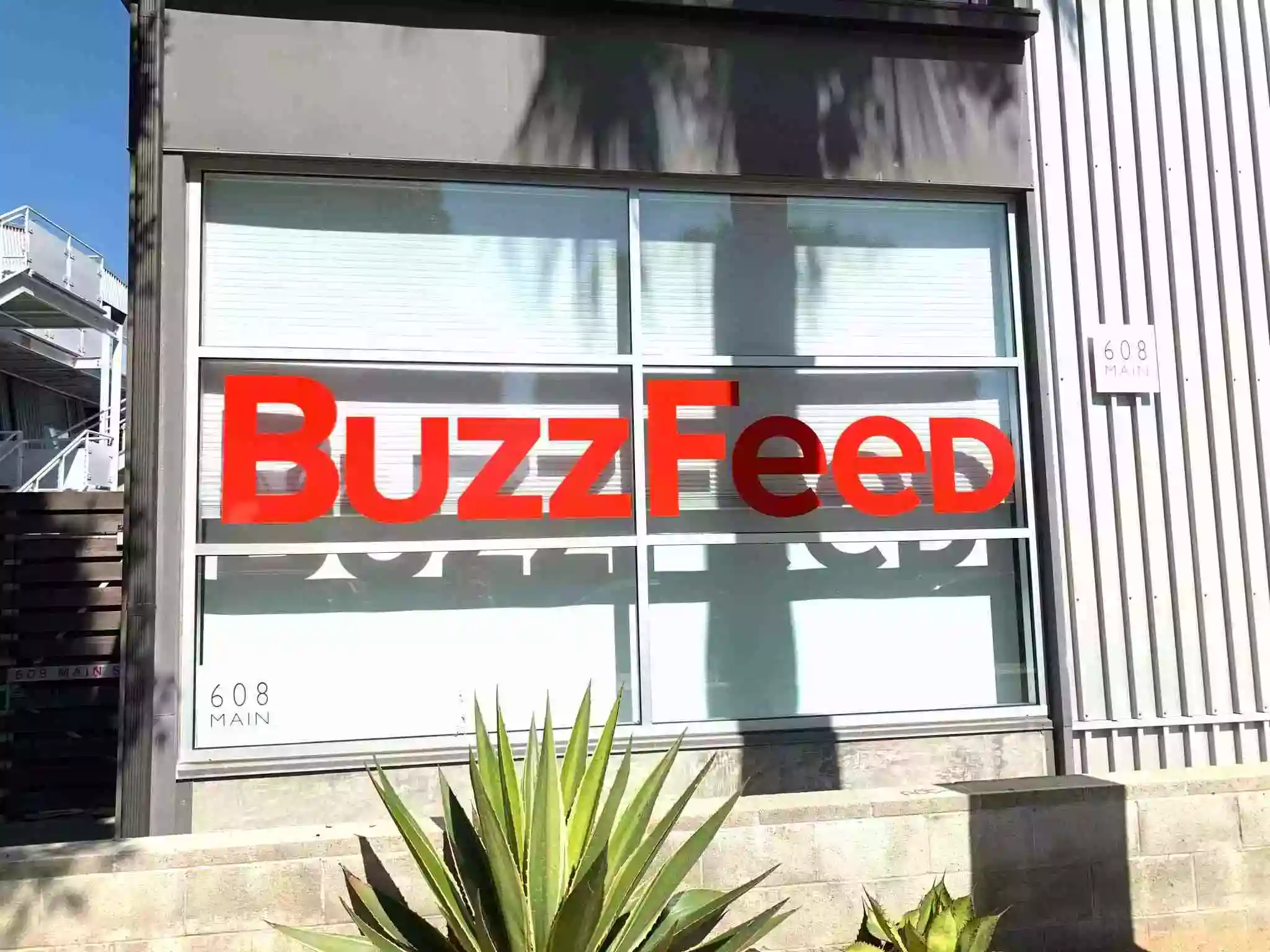Table of Contents
Why BuzzFeed?
We all know that the recession started in 2006, and most premium publishers, including The New York Times and The Guardian, were grappling with the sloping economy.
BuzzFeed was launched as a side project, exactly at the same time, by a media veteran and co-founder of The Huffington Post – Jonah Peretti. We believe it’s more than enough for us to see how they managed to become a $2 billion media giant. Besides, it moved against the grain right from the start.
Online publishers have been known to define and publish content in a specific structure/format. But BuzzFeed stayed away from all the traditional journalistic methods. It created listicles and viral stories, covered news, and didn’t confine itself to a specific topic.
Because BuzzFeed opened a platform that focused on sharing the most viewed pieces of media across the globe, and it knows people share when they like something, regardless of the topic. Many top-performing publishers thought the emoticon website wouldn’t last that long. But the publisher did it anyhow.
Today, we have Facebook, Instagram, Twitter, and many other social platforms equipped with many features. With their help, we can share anything with our colleagues, friends, relatives, etc. But roughly a decade ago, these social media platforms didn’t exist or were just evolving. When most digital media companies struggled to find a reliable content distribution platform, the publisher built a tool to use the audience as the primary distributor. Doesn’t it feel more like a product than a media company?
“It’s a big part of my routine. It’s a good tool, especially to see something I might have missed on Twitter or Facebook that someone else may have caught.”
– Andre Borges, Social News Reporter, BuzzFeed.
We don’t want to spill the beans yet. Let’s dive in; you’ll see for yourself.
How it all started?
Originally, Jonah Peretti launched BuzzFeed as an Internet Popularity Contest (Src) on Nov 2006. The brainchild of Peretti was intended to create a computer program that would share content with users daily. According to him, the content for its website should be a mixture of internet memes, listicles, and list of minutiae. The publisher aimed at posting contagious content that people possibly like to share.
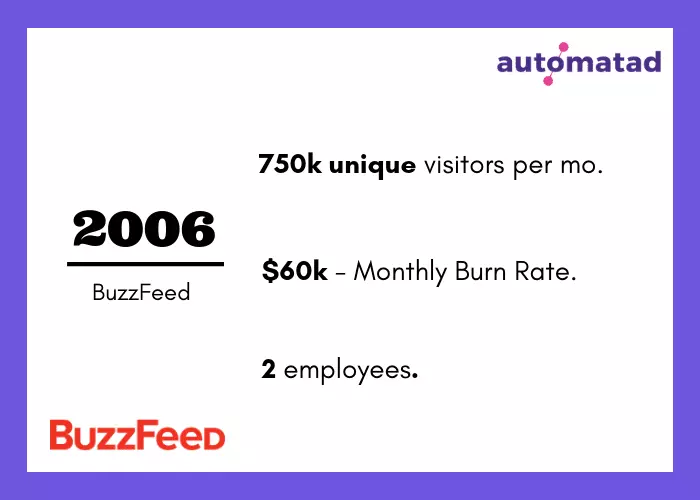
They ran the company with two people, including Mr. Jonah, and burned around $60k monthly to build the tool and get an audience of 750k per mo (Src).
Where are they today?
Once BuzzFeed had no editors or other staff members, the website could handle just five or six daily links. Half of them were from bots covering trending news of that day (Src). They have more than 18 offices worldwide with 1,300+ employees (Src).
A year after the launch of the publishing site, BuzzFeed had 927.5k Monthly Global Uniques (Src), and now they have more than 200M monthly unique visitors with 300M+ YouTube subscribers and 100+ Facebook pages (Src).
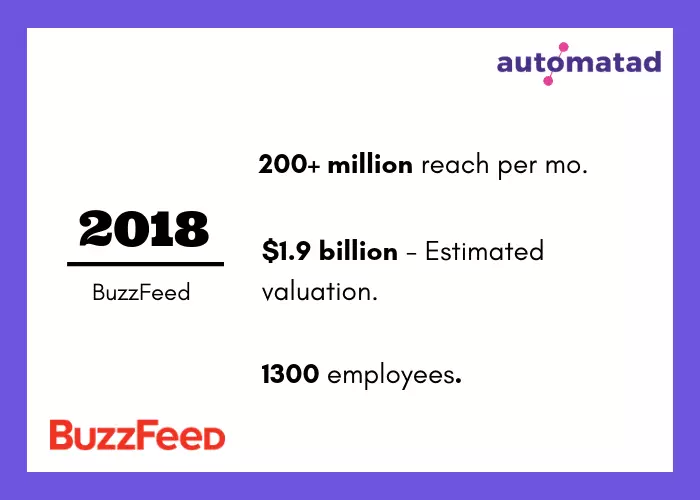
The uncommon thing was that Google or any other search platform wasn’t responsible for bringing traffic to the site. Most of the visitors were brought by other visitors who recommended them an article or blog post to check. Aggregating viral content from several sources was the theme for this publisher.
Evolution of BuzzFeed

Image Source: BuzzFeed.
The publisher always publishes content that is more likely to get shared than clicked. Since the genesis of the dot com era, when major publishing companies focused on SEO, keywords, tags, etc., BuzzFeed thought such content would only attract bots to read. It promoted its editors to write content that’s worth sharing.
Becoming BuzzFeed
Bots to Media
2006 – 2008
Instant Messaging Client
In 2006, BuzzFeed was launched with its tools – BuzzBot and Trend Detector. BuzzBot was an instant messaging client that shared viral links with its signed-up users, whereas Trend Detector processed data with the help of various algorithms.
The trend detectors were made to dig down more than 50,000 websites, blogs, and news sources and identify the most viewed links that have a greater chance of getting shared among people quickly. When the detector finds viral content, it’s passed to a special terminal interface. The editorial team of BuzzFeed used this interface to check the content processed by detectors and further publish it on the site after a few modifications.
After publishing the content on the site, BuzzBot sent users a link to the hottest content available on the Internet that day (Src). Whoever signs up for BuzzFeed‘s service gets the popular links sent by BuzzBot.
BuzzFeed in 2006:

The home page had links to the most popular videos, news articles, commentary, and other entertaining viral topics. The publisher didn’t look for the logic of the news before publishing content on its site. Shareability mattered more. In its earliest days, the publisher shared random funny content meant for entertainment.
Besides trend detectors and other tools, Google Trends helps the publisher to know about the most popular search by internet users and their preferences.
Bot + Humans
Peretti knew the key to a successful business isn’t always bringing clients or funds. Keeping your employees happy, engaged, and productive is equally important. Taking a step toward this, the publisher used to organize various in-office competitions and games for its employees.
He divided his small team into two and asked them to write as many articles as possible on a single topic. That’s how the publisher kept his staff engaged and created content in its starting days. Though BuzzFeed had real editors, the publisher allowed them to use pseudo names, especially if they wrote content on an unrelated topic. As the employees were using different names while posting different content, BuzzFeed staff seemed larger than it was.
At the beginning of 2007, the publisher realized it could not continue with computer programs alone and started looking for more editors as humans plus bots would yield better results. They had just six employees and two editors but garnered 2.5 million page views (Src).
Website Redesign
During the initial days of BuzzFeed, the two editors completely depended on computer algorithms to create editorial content.
In the mid of 2008, the publisher received $3.5M from its first investment partner Hearst Interactive Media Ventures and Softbank (Src). The infusion of $3.5M supported the publisher in redesigning its website. This newly designed website, dubbed ‘BuzzFeed 2.0,’ had links to viral videos, lists, quizzes, aggregated links, and buzzwords as usual.
Further, BuzzFeed advanced its algorithm to split the web site’s content into three sections – Raw Buzz, Detected Phrases, and Movers. Raw Buzz was automatically published content section under which editors were working with the help of trend detectors/algorithms. Detected Phrases were the trending phrases filtered out from various websites, whereas Movers compared trending topics in graphs and (+/-) digits.
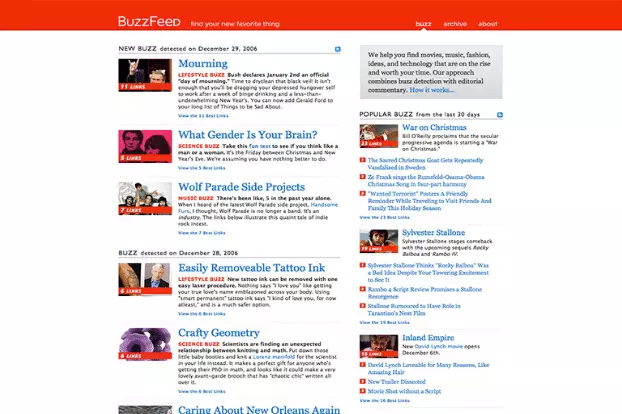
Self-serve Advertising Platform
As a step towards website monetization, the publisher added a new advertising platform that enables advertisers to use it for their brand awareness campaign. After all, the publisher had to grow its revenue to justify the funds.
The publisher knew that most visitors don’t prefer to see ads and prefer clutter-free content. Thus, the publisher offered its advertising partners to promote their brand in the format of its content so that it wouldn’t appear to users as regular ads. This idea was fresh for advertisers advertising through banner ads or other traditional formats and thought they could try it.
Also, the publisher introduced a widget network section to its website that enabled advertisers to promote their brand through it. Unlike other publishers who usually preferred behavioral targeting, BuzzFeed chose trend targeting as it placed ads next to its hottest content, thus highlighting content and ads – a win-win situation for both. Of course, the context was taken into account.
The reason is pretty simple. Unlike other media companies, BuzzFeed relied on users sharing the content to get reach and revenue. If you’re to annoy them with ads, then forget about the virality.
Second Round of Funding
There were no platforms reaching billions as we see today. BuzzFeed’s impressive reach and native ads wooed both advertisers and investors.
With the help of RRE Ventures, the viral-content company received $8M as its second round of funding in 2009. The publisher announced that the money received from its partners would be used to launch new products that would automatically manage the campaign motives for advertisers and publishers themselves. Along with the product, BuzzFeed aimed to hire 10 to 12 employees in the upcoming months (Src).
Content Distribution and Optimization
2010 – 2012
Native Advertising
At the beginning of 2011, Central Comedy and the publisher partnered to promote the former’s TV show Tosh.O on its site. After a few months, the publisher and AOL agreed on a business partnership that made BuzzFeed grant access to its platform to AOL for advertising its content.
As stated before, the publisher never liked the traditional format of advertising. Its business model relied completely on sponsored content for its brand advertisers.
Sponsored content brought a few extra bucks for the publisher and enormous traffic to its site. For example, a cat video ad published in partnership with Purina attracted more than 11M views (Src).
BuzzFeed also reached various other sites, including The Awl, DealBreaker, and Cracked.com, to publish sponsored content for its advertisers. These sponsored posts were displayed on the page of publishers in the same manner as their content was getting posted. According to a spokesperson of BuzzFeed, the publisher paid a minimum of $3 (CPM) to other publisher sites for promoting its advertising content on the given site.

Image source: NAYTEV Insights.
The Pinterest Code
Since its origin, BuzzFeed has always been familiar with the tone of digital media and how to target social platforms. For other publishers, Pinterest was just a platform to view pictures and skip, so they overlooked its importance. BuzzFeed, known for its uniqueness, found the social platform as a potential medium to bring traffic to its website and promote its business (Src).
Soon after observing its business worth, the publisher added Pinterest to its social media distribution plan and used the platform to deliver its content to millions.
BuzzFeed has 43k+ pins, 2M+ followers, and more than 10M+ monthly unique visitors to its Pinterest’s BuzzFeed page (Src).
“It’s a powerful platform for all kinds of content, not just quote standard Pinterest content.”
-Dao Nguyen, VP, BuzzFeed
Internal Dashboards
The publisher has done thousands of experiments and introduced various tools to reach its audience and build a better platform for its readers.
For instance, Buzzfeed has in-built dashboards for the editors. These dashboards are accessible to anyone from Buzzfeed, and they can use these tools to check how their posts perform on different platforms. El Dashboard is one of the most simplified dashboards BuzzFeed has. It can compare the performance of content published on two platforms, allowing editors to know where the content performed better.
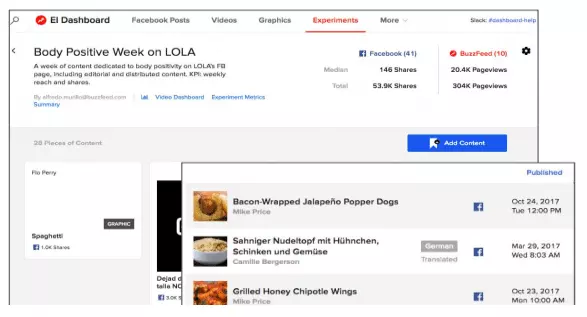
Another one is Dashbird, an advanced version of its internal dashboard El. It comes up with a metric known as Social Lift. Social Lift is the ratio of Viral views to Seed views. Viral news consists of page views collected outside of the publisher’s promotion campaigns, and Seed views are the page views from the publisher’s promotion campaigns. Dashbird enables the editors to check when and where their content is published on pages. It helps editors to know if their pre-scheduled benchmarks are being met on time.
By 2012, the publisher had completely changed the look of the website. It’s become user-friendly for visitors as there were new reaction icons LOL, OMG, and WTF options.

Additional Revenue Stream
Being a viral-content site, the publisher must stay updated with the current scenario of sharing content on its site and other websites. As the publisher already had in-built tools to track down how its content gets shared, it thought to utilize them to bring money for the publication.
In this direction, BuzzFeed partnered with other big publishers like the Daily Mail, the Huffington Post, New York Magazine, Time Inc, etc., and helped them to know from which platform their site is getting more traffic and where their content is getting shared.
Political Coverage
Till 2011, BuzzFeed had no section for political news. All it contained were entertaining posts. But the publisher found a shortcut to grow its online presence during the presidential election in 2012. The publisher knew that the people would be obsessed with election campaigns. Hence it launched the first political advertising content to bring people’s attention to the site. The publisher launched a campaign in the name of Obama for America on its site (Src).
Besides this, the publisher’s social media partner, Facebook, allowed BuzzFeed to access its network’s proprietary analytics. This revealed US visitors’ reviews about elections and various politicians’ actions. Many of its rivals, BuzzFeed, considered this partnership of the publisher and platform destructive to their growth (Source: Merchants of Truth – The Business of Facts and The Future of News (2019)).
The Face-off
2013 – 2015
Sponsoring Posts
Selling sponsored content from advertisers on its website has been one of the sources of revenue for BuzzFeed. But some big publishers say users sometimes don’t like to consume sponsored content.
The publisher bought traffic from Facebook, StumbleUpon, Twitter, and other content-marketing services to overcome such issues and drive more traffic. Whenever a sponsored post by BuzzFeed gets displayed on the news feed of users’ social media platforms, the publisher has to pay the price. This way, the publisher bought traffic to its site and met commitments made to the agencies.
Targeted Advertising
As a publisher, you might be aware of ad targeting and how it allows monetizing ad inventories. BuzzFeed introduced a new platform Social Discovery, also known as SoDisco, that helped the publisher build a custom audience.
Social Discovery is a platform that identifies and divides users into different groups and then targets the right audience in real time based on their response to the most recently viewed content.
Shoddy Editorial Practices
As a digital media publisher, BuzzFeed’s editors have acknowledged the website’s content model. But there have been many instances when BuzzFeed faced severe criticism for its shoddy editorial content. The publisher was famous but sometimes infamous.
A year ago, the publisher was pointed out by Gawker.com for plagiarizing content from other sites and, in most cases, from Reddit.
According to an article published by Gawker in 2012, BuzzFeed’s article “21 pictures that will restore your faith in Humanity” was quite similar to that of Nedhardy’s article “7 pictures that will restore your faith in Humanity” and “13 pictures that will restore your faith in humanity”.
As per the journalist, BuzzFeed editors assembled the same pictures from Nedhardy’s article and presented them slightly differently. Indeed, it attracted millions of page views, but Gawker’s article highlighted the publisher’s weak side (Src).
This wasn’t the last time BuzzFeed received plagiarism comments from its rivals. The following year, The Atlantic published another article accusing BuzzFeed of plagiarism. Though the publisher defended itself by saying that it transforms photographs into lists, rivals didn’t find it valid in any way. As a publisher, it’s always better to stay original.
Plagiarism Breach
In 2014, the publisher was again surrounded by critics as they found plagiarized content published by BuzzFeed on social media. Out of 500 articles posted by its political editor Benny Johnson, 41 were copied from other social media platforms or Wikipedia (Src).
Another plagiarism story came in 2016 when Akilah Hughes launched a campaign against BuzzFeed and published an article, Petition To Advertisers To Stop Supporting BuzzFeed Video (Src). The Youtuber accused the publisher of stealing her video ideas and content and re-publishing the content on its website without giving credit or compensation.
Though the publisher had millions of visitors, these breaches made the publisher less trustworthy, according to a report published by Pew Research Centre 2015 (Src). BuzzFeed later gained the audience’s trust and advertisers by creating original quizzes and interesting content rather than going after already published content.
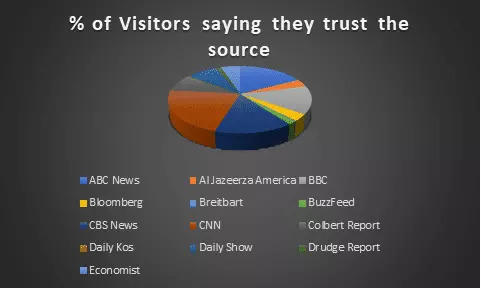
Third Round of Funding
It was at the beginning of 2013 when the publisher received $19M through its third round of funding from New Enterprise Associates, followed by Hearst Media, Lerer Ventures, SoftBank, and RRE Ventures, which raised its total money to $46M (Src). When asked, BuzzFeed said it would use the money to bring enormous traffic.
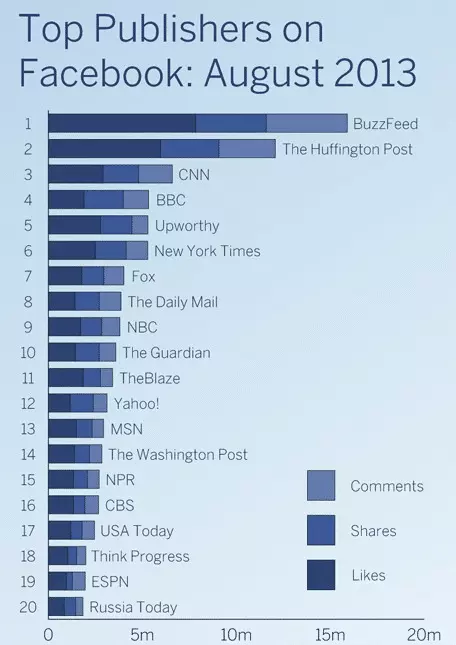
Image Source: Src
Advertising Formats
BuzzFeed has a clear vision of what readers would love to see, follow and share and how to write everything compellingly. The publisher hasn’t found this much success without a plan. Content strategy, business model, and different advertising formats have helped the publisher to reach a wide range of audiences with its various quizzes, videos, articles, and news.

Advertisement stories were highlighted using different parameters like background color, tags, etc.; some ads had “Featured Partner” at the bottom right side of the post. Such posts made its readers view the content and ads as well and hence doing promotion for both the publisher and the advertiser.
By 2013, the publisher had around 400 employees (Src) and reached 85 million people (Src). BuzzFeed grew its revenue by 215% to reap $64M (Src).
BuzzFeed, Off BuzzFeed
Content Partnerships
In March 2014, BuzzFeed made a zero-price partnership with Whisper, giving the Publisher access to its content. Whisper, one of the several messenger apps, allows its users to chat and share secrets anonymously. A team of 15 BuzzFeed editors filtered out potential content stored in the database of Whisper that could be popular among its visitors. Whisper said it would also help the publisher to provide more information on the subject with the help of its internal search engines. (Src).
Social Storytelling Program
To match native advertising standards with its own stories, the publisher started a new program SSCP (Social Storytelling Creator Programs), for its agencies. This program was meant to inform them of the BuzzFeed post formats, train them to produce content as the publisher’s content, and learn how to advertise at its best.
Besides this, the program gave agencies access to the publisher’s new features, innovative products, and many other benefits (Src). Also, accredited agencies were allowed to directly post their stories to the publisher’s site after getting approval from the editors. Though the publisher didn’t charge agencies directly, it has a minimum price for this program.
BuzzFeed Podcasts
In March 2015, BuzzFeed launched its first audio content (podcasts) – Another Round and Internet Explorer, to make content more accessible for its users. While Another Round focused on topics like gender, race, drinking, and pop culture, Internet Explorer worked on topics like the grosser sides of online culture.
BuzzFeed podcasts played an important role as a tool to increase website traffic. By the end of 2016, around 9M visitors downloaded various podcasts on the site (Src).
HIVE Software
HIVE is one of the gadgets BuzzFeed has built. This software allowed anyone from BuzzFeed to pull insights from the company’s archives and determine what type of content worked best for its visitors and on which platform its content yields better results.
Expansion Plan
To improve the structure of its business model and expand its audience reach to countries like Japan, India, Mexico, and Germany, BuzzFeed collected $50M from Andreessen Horowitz, a California-based venture capital firm. This round of funding raised its funds to $96.3M in six years. (Src). At this stage, the number of employees was over 500, and the publisher was reaching 150M+ people through its content. It made $46M in the first half of 2018 (Src).
BuzzFeed Distributed
Following the investment from Venture Capital, the publisher announced to launch of its new distributed division and named it “BuzzFeed, off BuzzFeed.” The distributed model had a team of twenty people who wrote original content for platforms like Snapchat, Instagram, Tumbler, Vine, etc. The team was asked to create content exclusively for the platforms, and those content wouldn’t be published on BuzzFeed (Src).
Top 10 Websites in the US (2014 Comcast Stats):
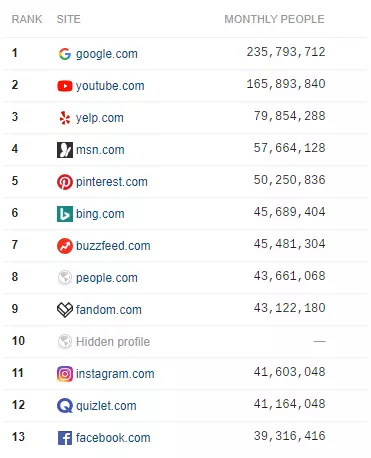
Dark Social
In today’s instant messaging apps/social media messengers, dark social (one-to-one data sharing) is becoming annoying for all publishers because it makes it difficult to measure traffic accurately. Even BuzzFeed has faced the consequences of dark social as its web articles go viral on social media platforms.
So, to reduce the implications of dark social, the publisher launched its new tool, Pound (Process For Optimizing And Understanding Network Diffusion), which can track content movement across the web. Pound processed more than 10,000 web requests per second, allowing an understanding of network diffusion (Src).
Although it didn’t save a username or PII (Personally Identifiable Information), it collected information based on URLs. The data stored by Pound helped the publisher to know where the content is getting shared frequently.
Facebook Instant Articles
Facebook and BuzzFeed have been in partnership since their evolution and always clearly understand how to use each other’s platform better for their business model. In 2015, Facebook enabled BuzzFeed to publish stories directly to its platform and called it the Instant Articles Program. Also, the social media giant offered reduced bounce rates for viewable stories within the Facebook application. It gave them complete freedom to post as much content as they wanted and promote them in any way.
Further, Facebook made a deal that if it sells ads around the content of the publisher (through Facebook Audience Network), it will give 70% of the revenue generated to the digital publisher, or if the publisher sells ads, then 100% of the revenue would be publisher’s (Src).
For BuzzFeed, which relies on people sharing its content across social media, trying out instant articles made sense. Everyone thought it a lucrative offer to earn revenue and increase reach on Facebook. But after a year, publishers began to drop out of Facebook IA as it was ineffective.
“There’s just no reason for publishers to continue to lose money on IA this far after launch.”
– Dan Check, Vice Chairman, Slate.
– Lesser Revenue
Publishers realized that they could make better revenue when visitors read the content on their site rather than as an instant article on Facebook.
– Lack of Control
Facebook decided on the ad density and implementation, not the publishers.
– Most importantly, no data
Publishers didn’t have the complete data to see the actual lift and make informed decisions. Facebook released aggregated/generic data. Here’s one example – Link clicks can increase from 20 to 50 percent when publishers use instant articles. But that’s not going to help a publisher in any significant way.
Content Management System
Unlike other digital publishers who relied on products offered by other sources, BuzzFeed has always worked with its technologies. BuzzFeed’s CMS has in-built tools – SuperPoster, and Mission Control. SuperPoster was created to edit and publish content, whereas Mission Control was meant to curate and promote pages on the right platform.
In addition, CMS included A/B testing as it helped the publisher optimize content and improve the reader experience. A/B testing enabled the editors and designers to evaluate design changes and site features. The results obtained after this were sent to its writers via Slack so that they could check which part of the content didn’t work as expected.
Finally, Into the Programmatic
2016 – 2018
Series G Funding
2016 the publisher received $200M from its new investment partner Comcast/NBCUniversal (Src). The investment enabled the publisher and the partner company to sell respective content on each other’s platforms. This wasn’t the first and last time NBC Universal invested in the company. Later, in 2018, it again partnered with the publisher raising the total investment amount to $400M (Src).
During the Rio Olympics, NBC selected a team of 12 BuzzFeed members and asked them to create at least 20 pieces of content per day. The video content produced by the editorial team were posted on different social media platform, including BuzzFeed. In exchange, NBC Universal aired BuzzFeed’s video content to its various channels.
But BuzzFeed, like other media companies, faced inevitable ups and downs. Despite receiving this small from NBC Universal, BuzzFeed had consecutively missed its revenue goal for two years and attracted its lowest number, 72M unique visitors in the US (Src).
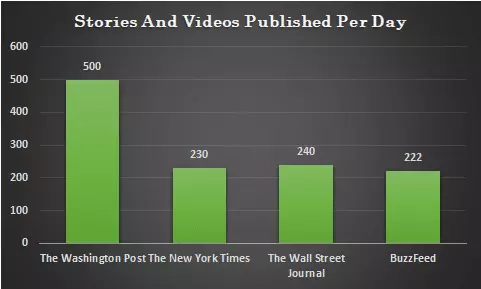
Graph Source – Src
e-Commerce Strategy
The entertainment giant BuzzFeed introduced its “BuzzFeed Shop” for its visitors in 2016. The publisher took another step towards collecting revenue for the company’s operation and making it a fast-growing business. Ahead of that, the publisher had opened a BuzzFeed Swag Shop for its employees, and according to the publisher’s sources, it was a big success (Src).
Publisher’s Division
In 2016, BuzzFeed Inc announced its division into two groups – entertainment (buzzfeed.com) and news (buzzfeednews.com). The BuzzFeed Entertainment Group started taking care of entertainment content like quizzes, lists, videos, etc., whereas BuzzFeed News focused on providing sensible news to its consumers.
Brand Awareness Campaign
As an awareness campaign, BuzzFeed started an hour-long morning news show, AM to DM, on Twitter. The show, launched in September 2017, attracted more than 1M unique daily visitors, and more than 10M visitors saw the clips presented in the show in its first week (Src). The show was similar to BuzzFeed’s, highlighting the biggest news stories, trending tweets, and expert advice.
By the end of 2018, the show started with just two members, had more than 500 guests, and already collected 101M impressions on Twitter, i.e., 3M impressions each week, according to the publisher (Src).
| Month/Year | Number of Videos Uploaded | Number of Posts Uploaded |
| April 2012 | 10 | 914 |
| April 2015 | 205 | 5,271 |
| April 2016 | 319 | 6,365 |
– Src
Programmatic Advertising
Native advertising has been growing for years, and BuzzFeed has relied on that since its genesis. But avoiding traditional advertising formats and programmatic approaches for a long is hard. BuzzFeed has done this in previous years but has recently stepped into the programmatic platform due to increased demands for programmatic ads and better user experience for its readers.
Tactically, programmatic has improved loading times, mobile experience, and ad quality, and it opens up another way for us to monetize our huge audience. The move also benefits our global strategy by allowing us to generate revenue in markets before we’ve built business teams to implement native monetization.
– Jonah Peretti, Founder, BuzzFeed.
Compared to the certain missed targets of previous years, BuzzFeed’s programmatic ads helped the publisher raise its monthly impressions from 1B to 3B (Src).
“1.39s Load Time”
– Src.
For publishers, analyzing data patterns in real-time is quite important as it helps them to target their audience at the right place and time and thus maximize the ad impressions. Meanwhile, other publishers were opting for data science teams, and BuzzFeed started working with Looker, a data management platform that allowed its employees to gather and analyze data. Looker collected data from different platforms and stored them in its database.
Recently, the publisher has replaced its cookie-dependent DMP and switched to Permutive, which doesn’t store data in cookies. According to a spokesperson from BuzzFeed’s programmatic team, the former DMP was quite slow and couldn’t track user behavior over a longer time. Also, the rate of data degradation was too high and quick, which was making difficult to store and compare historical data.
Now, the publisher can track readers’ behavior for a long time and then segment user groups based on certain points. Also, Permutive consists of an additional feature – cross-device tracking capability, which helped the publisher in frequency capping.
Community Management
Getting a DMP helped the publisher in many ways. Since BuzzFeed got a new tool to look after the data part, the publisher made its editors focus on other things like community management. BuzzFeed used Slack and Slack Bots to notify its editors from other parts of the world about trending news going viral online.
Google DouInternet Ad Exchange (now Google Ad Manager)
After deciding to run banner ads on its website, the publisher announced that it would display ads with the help of third-party ad technologies. The advertisers were allowed to run ads through the Google DoubleClick Ad Exchange and Facebook Audience Network (Src). However, many major ad exchanges now deliver ads to BuzzFeed.com as the publisher implemented header bidding.
With the help of DoubleClick and its Ads Distribution team, the publisher allowed ads that suited the quality of the website. If it didn’t match their standards, then the ad slots collapsed.


Image Source: BuzzFeed
Also, BuzzFeed’s Ad Group and Ad Distribution team have implemented Private Marketplaces (PMP) to offer its agencies high-quality and consistent advertising experiments.
A year later, the publisher introduced the first native programmatic ad tools for its advertisers. The newly launched tools allowed advertisers to purchase branded quizzes and re-use print and TV content available on BuzzFeed (Src).
Affiliate Marketing
The publisher entered into a partnership with Shopify to compensate for missed revenue targets from the previous years. Under this partnership, Shopify added a new channel to its site, “BuzzFeed Channel,” which enabled advertisers across the globe to tag their products for the editors of BuzzFeed.
When the editors found a suitable ad or product trending on Shopify’s BuzzFeed channel, they would display the ad with the content on the website. Further, it built software that helped the editors to know if the ad content was a success and gave a rough idea of revenue generated by the ad.
BuzzFeed strictly had no minimum commission criteria but expected 10% to 25% per sale from Shopify merchants. The same year, the publisher initiated an affiliate agreement with Skimlinks, a content-monetization and contextual advertising platform.
BuzzFeed Exchange
To meet its client expectations and increase the revenue rate, the publisher launched its new programmatic platform, BuzzFeed Exchange – an expansion of its programmatic products. BuzzFeed offered a unified platform for its advertisers that gave them access to BuzzFeed News, BuzzFeed apps, Nifty, and other BuzzFeed properties in one place.
Commerce Revenue
By the end of 2018, BuzzFeed was reached by The Scotts Miracle-Gro Company in the hope of advertising and selling its products on the publisher’s site. To assist Scott’s Group, the publisher made a group of 60 people, and since its start, this team has generated more than $50M by combining commerce and advertising (Src).
Conclusion
Undoubtedly, the publisher understands the Internet better than anyInternet and attracts millions of visitors daily with its cheesy content titles and clever wording.
Taking its digital media to print media, the viral media giant released its first print newspaper exclusively in New York a month ago. While most media companies are going online from their print edition, it isn’t less than a stunt for BuzzFeed as it has taken a step toward the reverse direction. Though the publisher said this would be the first and last edition of its print magazine, we can expect a lot more new experiments by the publisher. It even launched paid membership plans for its news site, aiming to cover news content extensively rather than skimming the surface. BuzzFeed believes it can lure in subscribers with its reach and original reach.
We know native advertising and programmatic have become a part of the publisher (and that’s proven to help other publishers like you, too); let’s see how eCommerce and subscription turn out.


